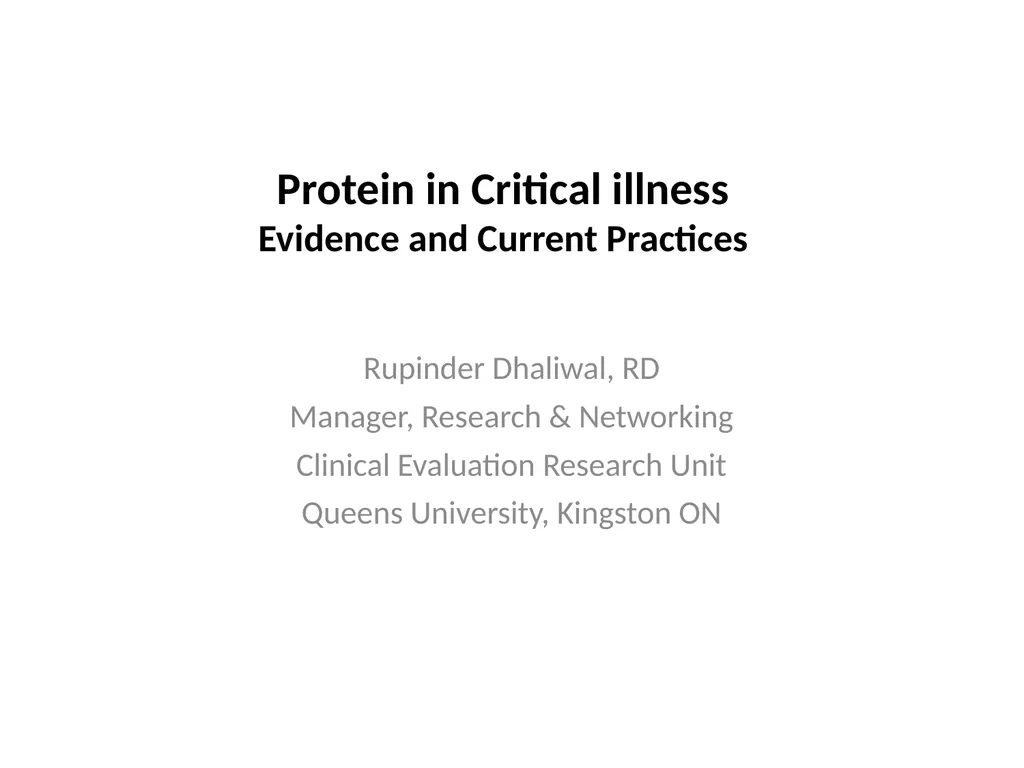Protein in Critical illness Evidence and Current
Author : liane-varnes | Published Date : 2025-11-08
Description: Protein in Critical illness Evidence and Current Practices Rupinder Dhaliwal RD Manager Research Networking Clinical Evaluation Research Unit Queens University Kingston ON Learning Objectives You will become familiar with the Latest
Presentation Embed Code
Download Presentation
Download
Presentation The PPT/PDF document
"Protein in Critical illness Evidence and Current" is the property of its rightful owner.
Permission is granted to download and print the materials on this website for personal, non-commercial use only,
and to display it on your personal computer provided you do not modify the materials and that you retain all
copyright notices contained in the materials. By downloading content from our website, you accept the terms of
this agreement.
Transcript:Protein in Critical illness Evidence and Current:
Protein in Critical illness Evidence and Current Practices Rupinder Dhaliwal, RD Manager, Research & Networking Clinical Evaluation Research Unit Queens University, Kingston ON Learning Objectives You will become familiar with the Latest evidence behind optimizing nutrition and protein intake in critical illness Current protein intakes in ICU patients: results of the International Nutrition Survey 2013 Recent efforts at improving the delivery of protein in ICUs The PEP UP Protocol use of supplemental parenteral nutrition in high risk patients Review of Evidence Guidelines: SCCM/ASPEN 2009 Add refs or papers Guidelines: ESPEN 2009 Add refs or papers Guidelines: Canadian 2013 Conflicting evidence Surviving Sepsis Campaign Guidelines CCM Feb 2013 Conflicting evidence EDEN study results Rice results Arabi Conclude that need to focus on “high risk patients”..Charlene to discuss this in detail Recent review on protein Hoffer et al Meta-analysis of 13 RCTs Show results Conclusions: 2.5 g/kg/day is safe and effective Point prevalence survey of nutrition practices in ICU’s around the world conducted Jan. 27, 2007 Enrolled 2772 patients from 158 ICU’s over 5 continents Included ventilated adult patients who remained in ICU >72 hours 113 select ICU patients with sepsis or burns On average, receiving 1900 kcal/day and 84 grams of protein No significant relationship with energy intake but…… Clinical Nutrition 2012 Observational studies: protein results in better outcomes Elke Critical Care 2013: Only briefly mention this but Charlene to talk about results in more detail? Current Practices INS 2013 International Nutrition Survey (INS) 2013 Purpose illuminate gaps between current practice & guidelines identify practice areas to target for change History started in Canada in 2001 5th International audit (2007, 2008, 2009, 2011 & 2013) Methods Observational, point prevalence study Methods Each ICU enrolled 20 consecutive patients ICU LOS> 72 hrs vented within first 48 hrs Data abstracted from chart Hospital and ICU characteristics Patient information Baseline Nutrition Assessment Daily Nutrition data Patient outcomes (e.g. mortality, length of stay) Benchmarking Report provided Best of the Best Competition if n ≥ 20 patients www.criticalcarenutrition.com Canada: 24 USA: 52 Australia & New Zealand: 36 Europe & Africa: 35 Latin America: 14 Asia: 41 Colombia:6 Uruguay:4 Venezuela:2 Peru:1 Mexico: 1 Turkey: 11 UK: 8 Ireland: 4 Norway: 4 Switzerland: 3 Italy: 1 Sweden: 1 Spain: 1 South Africa: 2 Japan: 21 India: 9 Singapore: 5 Philippines:2 China: 2 Iran : 1 Thailand: 1 Participation: INS 2013 202 ICUs 26 nations 4040 patients 37,872 days













